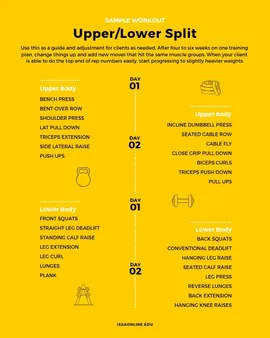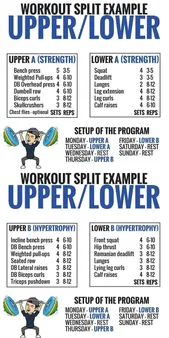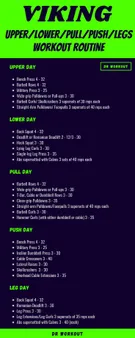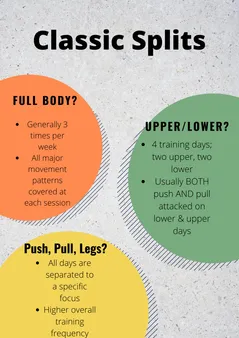Table of Contents
If you're interested in a challenging and effective workout routine, then you may want to consider an upper lower calisthenics split. This type of split involves dividing your workouts into two parts: one for your upper body and one for your lower body. This allows you to focus on each muscle group more effectively and can help you to achieve your fitness goals faster. In this article, we will discuss the benefits of an upper lower calisthenics split, provide a sample workout plan, and offer tips for getting the most out of this type of training. Whether you're a beginner or an experienced athlete, an upper lower calisthenics split can help you to take your fitness to the next level.
The Ultimate Guide to Upper Lower Calisthenics Split: A Comprehensive Workout Plan
I. Key Takeaways
| Aspects | Upper Lower Calisthenics Split |
|---|---|
Exercise Focus | Divides workouts into upper and lower body on separate days |
Pros |
|
Cons |
|
Suitability for Beginners | Generally not recommended for beginners due to intensity and complexity |
Tips for Beginners |
II. Calisthenics: Three Ways to Split Your Workout
Full-Body Split
In a full-body split, you work out all of your muscle groups in each workout session. This is a good option for beginners because it allows you to work all of your muscles regularly. However, it can be time-consuming, and it may not be the most effective way to build muscle.How to Do a Muscle Up
Upper/Lower Split
In an upper/lower split, you divide your workouts into two days: one day for upper body and one day for lower body. This is a good option for intermediate and advanced lifters who want to build muscle more effectively. It allows you to focus on each muscle group more intensely, and it can help you to recover more quickly between workouts.The Best Calisthenics Gifts and Accessories
Push/Pull/Legs Split
In a push/pull/legs split, you divide your workouts into three days: one day for pushing exercises, one day for pulling exercises, and one day for leg exercises. This is a good option for advanced lifters who want to maximize muscle growth. It allows you to focus on each muscle group even more intensely, and it can help you to recover even more quickly between workouts.The Best Calisthenics Quotes and Motivation
Split | Pros | Cons |
|---|---|---|
Full-Body Split |
|
|
Upper/Lower Split |
|
|
Push/Pull/Legs Split |
|
|
Ultimately, the best way to split your workout is the one that works best for you. Consider your fitness level, your goals, and your schedule when making your decision.How to Get Started with Calisthenics as a Beginner
Calisthenics: Three Ways to Split Your Workout
III. Volume and Frequency Considerations
Determining the Right Workout Volume
The optimal workout volume for an upper lower calisthenics split depends on several factors, including fitness level, goals, and recovery capacity. Beginners may start with a lower volume of exercises and gradually increase it as they progress. Advanced athletes may opt for a higher volume to continue challenging their bodies and promoting growth.How to Train Like a Calisthenics Pro
Factors to Consider | Explanation |
|---|---|
Fitness Level | Beginners require a lower volume to avoid overtraining, while advanced athletes can handle more. |
Goals | Those seeking strength gains may focus on a lower volume with heavier weights, while those prioritizing endurance may benefit from a higher volume with lighter weights. |
Recovery Capacity | Adequate rest is crucial for muscle recovery and growth. Adjust volume based on individual recovery needs. |
Balancing Frequency and Volume
Frequency refers to how often you train each muscle group per week. For an upper lower split, each muscle group is typically trained once every 2-3 days. Balancing frequency and volume is crucial to optimize results and minimize the risk of overtraining.Benefits of Calisthenics for Bodyweight Training
- Training each muscle group multiple times per week allows for more frequent stimulation and potential growth.
- However, high frequency with excessive volume can lead to fatigue, reduced recovery, and diminished results.
- Finding the right balance is essential for optimal progress.
Volume and Frequency Considerations
IV. Sample Upper/Lower Split Workout Plan
The upper/lower split workout plan is a popular way to divide your workouts into two sessions. On upper body day, you'll focus on exercises that work the muscles in your chest, back, shoulders, and arms. On lower body day, you'll focus on exercises that work the muscles in your legs and glutes.
Here's a sample upper/lower split workout plan for beginners:
Exercise | Sets | Reps | Exercise | Sets | Reps |
Pull-ups (assisted if needed) | 3 | 8-12 | Squats | 3 | 10-15 |
Push-ups | 3 | 8-12 | Lunges | 3 | 10-15 each leg |
Rows | 3 | 8-12 | Calf raises | 3 | 15-20 |
Overhead press | 3 | 8-12 | Glute bridges | 3 | 10-15 |
Tricep extensions | 3 | 10-15 | Hamstring curls | 3 | 10-15 |
Bicep curls | 3 | 10-15 | Plank | 3 | Hold for 30-60 seconds |
You can adjust the sets, reps, and exercises in this plan to fit your fitness level and goals. For example, if you're new to calisthenics, you may want to start with 2 sets of each exercise and gradually increase the number of sets as you get stronger.
The upper/lower split workout plan is a great way to improve your strength, muscle mass, and fitness. If you're looking for a way to take your calisthenics training to the next level, give this workout plan a try.
- Follow our Muscle-Up Guide to learn the proper technique.
- Gift ideas for your loved ones.
Sample Upper/Lower Split Workout Plan
V. Conclusion
The upper lower calisthenics split is a great way to build muscle and strength. It is a challenging but rewarding workout that can help you achieve your fitness goals. If you are looking for a new workout routine, I encourage you to give the upper lower calisthenics split a try. You may be surprised at how quickly you see results.